
The beer distribution game dates to the earliest days of system dynamics. The game has been used for decades as an introduction to systems thinking, dynamics, computer simulation and management. It has been played by thousands of people all over the world from high-school students to CEOs of major corporations.
- Instructions
- Supplies Checklist
- Steps of the Game
- Outline for Post-Game Discussion
- Mock-up of the Game Board
- Graphs/Charts
- Downloadable PDF Forms
- Bibliography
Instructions
The beer distribution game can be played by as few as four and as many as 60 people (assistance is required for larger groups). The only prerequisite, besides basic math skills, is that the none of the participants have played the game before or else agree not to reveal the trick of the game. The object of the game is to minimize total costs for your team.
Purpose
- Introduce people to the key principle “structure produces behavior”
- Experience the pressures of playing a role in a complex system
Overview of production-distribution system
- Identify the four positions: retailer, wholesaler, distributor and factory
- Each position is identical (except for the factory). Each has an inventory of beer. Each receives orders from and ships beer to the sector downstream. Each orders beer from the sector upstream. Beer is received after a shipping delay. (In the case of the factory, beer is received after a production delay.) Orders are received after a mailing delay.
Basic rules
- Have each team pick a name for their brewery – use the name of a real beer. Have them label their record sheets with the name of their brewery and their position – retailer, wholesaler, etc.
- Have each person ante up $1.00, or an appropriate amount, which will go to the winning team – winner take all.
- The object of the game is to minimize total costs for your team. The team with the lowest total costs wins. Costs are computed in the following way:
- The carrying costs of inventory are $.50 per case per week.
- Out-of-stock costs, or backlog costs, are $1.00 per case per week.
- The costs of each stage (retailer, wholesaler, distributor, factory) for each week, added up for the total length of the game, determine the total cost.
- There should be no communication between sectors. Retailers should not talk to anyone else, nor should wholesalers, distributors or factories. The reason for this is that in real life there may be five factories, several dozen distributors, thousands of wholesalers and tens of thousands of retailers, and each one cannot find out what the total activity of all the others is. The only communication between sectors should be through the passing of orders and the receiving of beer.
- Retailers are the only ones who know what the customers actually order. They should not reveal this information to anyone else.
Steps of the game
The game leader should call out the steps as the game progresses. The first few times when the system is still in equilibrium the leader should go through the steps very slowly to make sure people have the mechanics down. Notice that of the five steps of the game, only the last, placing orders, involves a decision. The first four steps only involve moving inventory of beer or order slips, and are purely mechanical. For the first few weeks the leader should tell everyone to order four units to keep the system in equilibrium.
Initialization of the boards
There should be 12 pennies or chips representing 12 cases of beer in each inventory. Each chip or penny represents one case. There should be four pennies in each shipping box and production delay. There should be order slips with “4” written on them, face down in each order box (orders placed, incoming orders and production requests). A supply of blank order slips should be available at each sector, as well as a supply of pennies or chips.
The deck of cards with the customer demand should not be revealed in advance. The pattern of customer demand that is most effective for first-time players is a pattern of four cases per week until week five, and then eight per week from week five on. Each order deck should have 50 weeks’ worth of cards, and the players should be told that the game will be 50 weeks long. Typically it’s only necessary to run the game 35 weeks or so in order to see the pattern of fluctuation, but telling the players it will be 50 weeks prevents horizon effects, where they run their inventories down because they feel the end of the game is coming.
Tips
- It’s very helpful if the game leader makes sure that each team stays in step so that you can quickly glance around the room and see that everyone is at the right place.
- The game leader should write the current week on the blackboard as the steps for that week are called out.
- In about the eighth or ninth week the retailer will run out of inventory and have a backlog for the first time. People do not understand the meaning of backlogs, or the cumulative nature of the backlog.
- It is necessary to stop the game at this point, ask everyone to pay attention, and explain how backlog accounting works. Explain that the backlog represents orders you’ve received, but have not yet filled, and which you must fill in the future.
- Explain that the backlog is cumulative. “Next week you have to fill the incoming orders that you receive, plus whatever is in your backlog, if possible. If not possible, then the amount left over is added to the existing backlog and must be filled in later weeks.”
- Emphasize at this point that backlog costs twice as much as inventory. You may need to do this one or two more times, and should be careful to check and be sure that they do in fact fill their backlog. It is helpful to write the following equation on the blackboard to help with backlog accounting:
Orders to fill = New orders + Backlog this week this week last week
- The game can be played in as little as one and a half hours if the leader maintains a brisk pace. The debriefing usually requires at least 40 minutes and can be expanded substantially.
Supplies Checklist
| Per Team | 3 Teams | 4 Teams | 5 Teams | 6 Teams |
| Game board (1) | 3 | 4 | 5 | 6 |
| Single chips (80 + 160) | 600 | 840 | 960 | 1200 |
| 10 chips | 90 | 120 | 150 | 150 |
| Customer deck (1) | 3 | 4 | 5 | 6 |
| Order slips (200) | 600 | 800 | 1000 | 1200 |
| Graphs (4) | 12 | 16 | 20 | 25 |
| Record sheets (4) | 12 | 16 | 20 | 25 |
| Pencils (4) | 12 | 16 | 20 | 25 |
| Calculators (2) | 6 | 8 | 10 | 12 |
Per Session
- Masking tape
- Four-color markers
- Debriefing book
- Magic markers
- Flip charts
- Previous game graphs
- Table set-ups
Steps of the Game
- Receive inventory and advance the shipping.
- Factory advance the production delay.
- Look at incoming orders and fill orders.
- All incoming orders plus orders in backlog must be filled.
- If your inventory is insufficient to fill incoming orders plus backlog, fill as many orders as you can and add the remaining orders to your backlog.
- Record your inventory or backlog.
- Advance the order slips.
- Factories introduce production requests from last week into the production delay.
- Place and record your orders.
Outline for Post-Game Discussion
1. Get all the graphs of results (orders, “effective inventory” = inventory-backlog) taped up on the blackboard.
2. Find out which team won (lowest total cost).
3. Although they played the game to minimize cost, that’s not the real purpose of the game. The game is designed to:
- Give them an experience of playing a role in a system.
- Show them how “structure produces behavior.”
4. Ask participants what their experience of playing the game was. Some good leading questions are:
- Did you feel yourself “at the effect” of forces in the system (i.e., relatively helpless in the face of huge incoming orders or excess inventories) from time to time?
- Did you find yourself “blaming” the person next to you for your problems?
5. After a few minutes (about 10) of discussion, look at the graphs of the results. Ask the participants, “What commonalities do you see in the graphs for the different teams?” Participants should see common pattern of overshoot and oscillation. This should be most evident in the effective inventory graph.
- Get them to really see for themselves that different people in the same structure produce qualitatively similar results. Even though they acted very differently as individuals in ordering inventory, the overall patterns of behavior are similar.
- Differences in individual ordering patterns (free will) result in the quantitative differences in game results. But the qualitative patterns are the same.
- This is an important point – take as long as necessary to have them see it for themselves. You might reflect at this point on what happens in the real world when such order-rate and inventory oscillations are generated.
- The typical organizational response is to find the “person responsible” (the individual placing the orders or the inventory manager) and blame that person. The game clearly demonstrates how inappropriate this response is – different people following different decision rules for ordering a generated oscillations.
6. After having had them all see the extent to which different people produce similar results in a common structure, you then need to move on to what is usually the most powerful point made by the game: that internal structure, not external events, causes system behavior. The way to make this point is to ask the following question: “All of you who were not retailers, or who otherwise have not found out what the pattern of customer orders was, what do you think the customers were doing?”
- Most people usually believe that customer demand was fluctuating because they believe that the system fluctuations must have been externally driven. Get each of them (other than retailers) to see that they assumed fluctuating customer orders.
- Draw in each order-rate graph, the customer-ordering pattern. The small step from four to eight orders should make a strong visual impression in contrast to the order rate fluctuations which often have amplitude of 20 to 40 orders per week. Moreover, the sustained oscillations generated by the system contrast sharply to the absolutely flat customer order rate after the step at week five.
- This simple exercise of getting them to see how, contrary to their expectations, the internal system structure is capable of generating fluctuating behavior is the most profound lesson they can learn from the game. It is important that they see this for themselves as a demonstration or an experimental result that they did, not as an idea of which you’re trying to convince them. In fact, the game is an experiment in a true sense. The result of oscillating behavior was not predetermined.
- The assumption that the system’s problems are caused by the customer stems from the external orientation most of us adopt in dealing with most problems. In a sense, this is just an extension of the viewpoint that attributes your problems to the person(s) playing next to you in the game: “he/she did it to me” is a special case of “they (the customers) did it to me.” In system dynamics we take an alternative viewpoint – that the internal structure of a system is more important than external events in generating qualitative patterns of behavior.
- This can be illustrated by the following:
structure ⇒ behavior/process (oscillation) ⇒ events
(events meaning inventory stock-outs and extreme order surges)
- Most people try to explain reality by showing how one set of events cause another or, if they’ve studied a problem in more depth, by showing how a particular set of events are part of a longer-term historical process.
- Have the students illustrate this for themselves by looking at their own “explanations” for events during the game. Take a particular incident in the game – for example a large surge in production requests at the factory – and ask the person responsible why he or she did that. That person’s answer will invariably relate the decision to some prior decision of the person being supplied or who supplies them. Then turn to that person and ask them why he or she did that. Continue this until people see that one can continue to relate one event to earlier events indefinitely.
- The basic problem with the “events cause events” orientation is that it gives you very little power to alter the course of events. The focus on internal structure greatly enhances the possibilities of influencing the course of events because you are dealing with the underlying source of the process, not just trying to manipulate events.
7. If time permits, have students think of examples of problems that can be viewed as internally or externally caused (e.g., illness, famine).
- This leaves you at the point of dealing with the problem: “How do we deal more effectively with underlying structure?”
- This is the purpose of system dynamics. You are now in an excellent position to begin introducing system dynamics tools for understanding underlying structure.
Mock-up of the Game Board
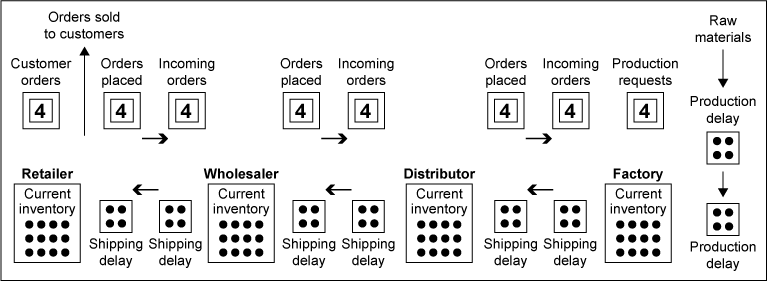
Graphs/Charts
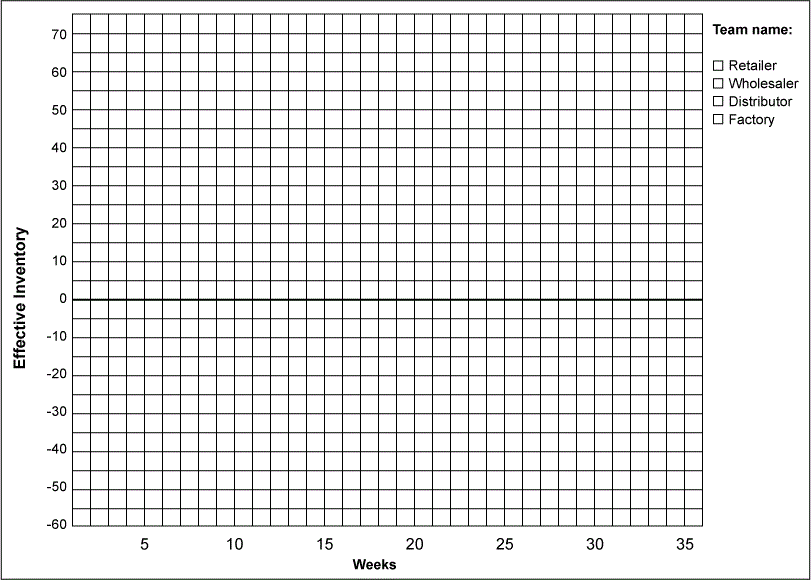
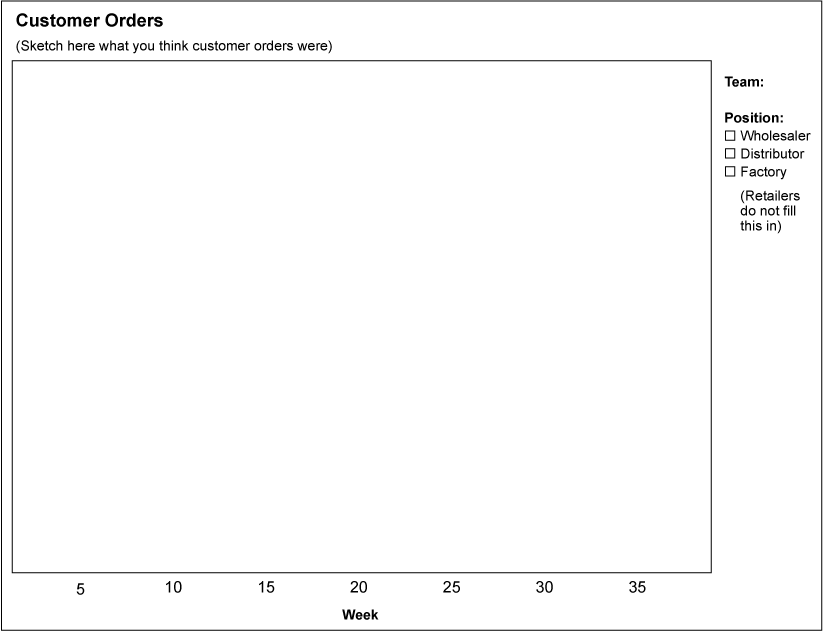
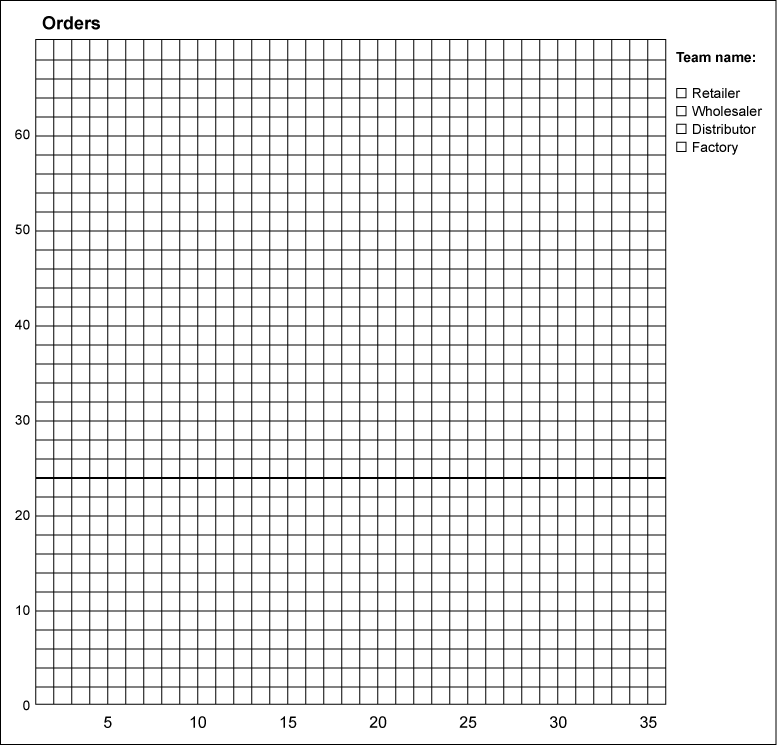
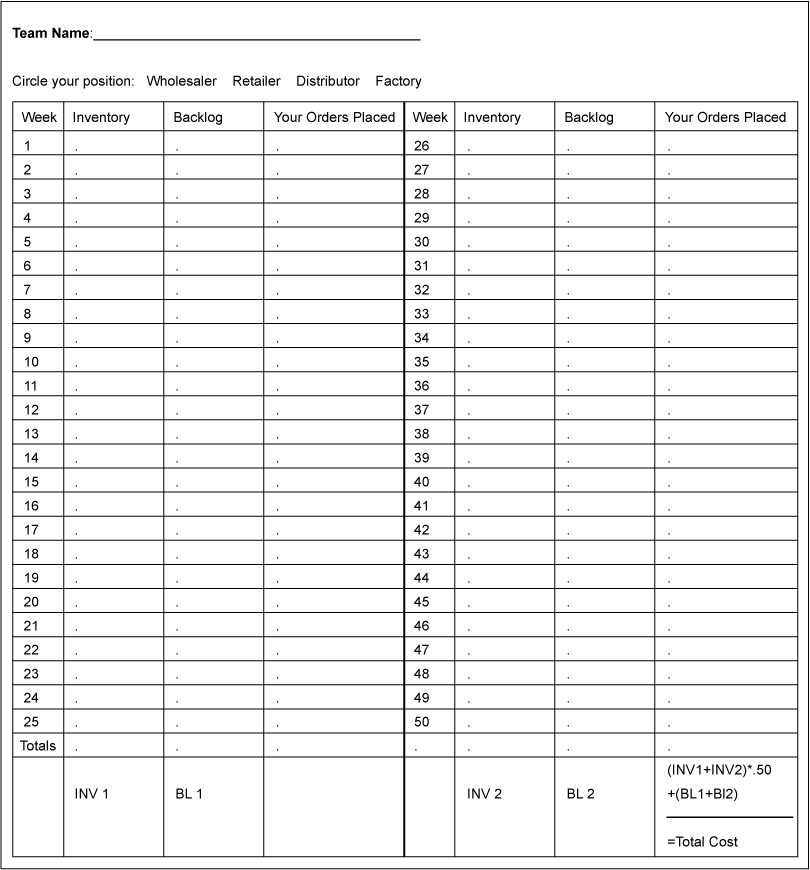
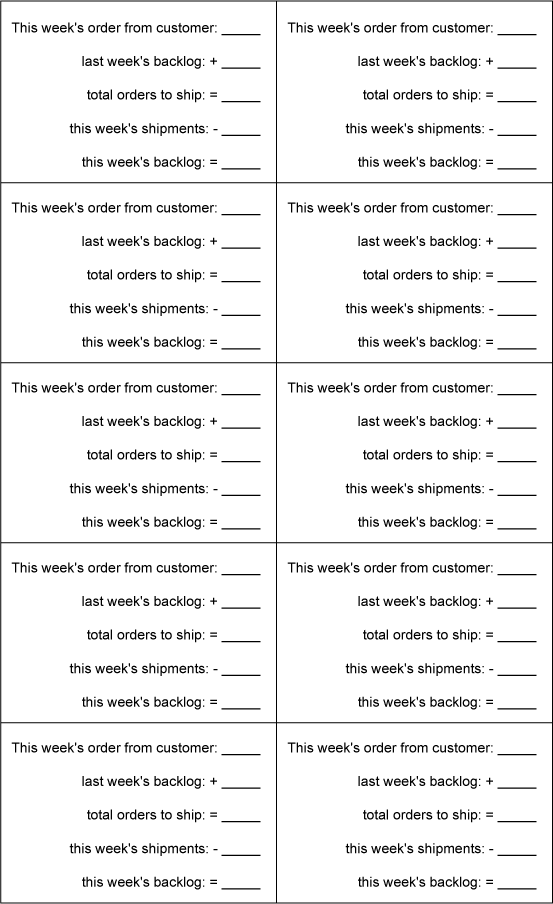
Downloadable PDF Forms
Bibliography
Forrester, J.W. (1958) “Industrial Dynamics: A Major Breakthrough for Decision Makers.” Harvard Business Review, 36(4), July/August, 37-66.
-
-
- The first article in the field of system dynamics. Presents the production-distribution system as an example of dynamic analysis of a business problem. Reprinted in Roberts (1978).
-
Forrester, J.W. (1961) Industrial Dynamics. Cambridge, MA: MIT Press.
-
-
- Contains a description of an early version of the Beer Distribution Game.
-
MacNeil-Lehrer Report, (1989) Risky Business – Business Cycles, Video, Public Broadcasting System, aired 23 October 1989.
Videotape showing students in John Sterman’s Systems Dynamics course at MIT playing and discussing the Beer Game. Relates the game to boom and bust cycles in the real world. Excellent in debriefing the game, and helpful to those seeking to learn how to run the game. Copies available from System Dynamics Group, E60-383, MIT, Cambridge MA 02139.
Mosekilde, E., E. R. Larsen & J. D. Sterman (1991). Coping with Complexity: Deterministic Chaos in Human Decision Making Behavior. In J.L. Casti & A. Karlqvist (Eds.), Beyond Belief: Randomness, Prediction, and Explanation in Science, 199-229. Boston:CRC Press.
-
-
- Shows how simple and reasonable decision rules for playing the Beer Game may produce strange nonlinear phenomena, including deterministic chaos.
-
Radzicki, M. (1991). Computer-based beer game boards. Worcester Polytechnic Institute, Dept. of Soc Sci and Policy Studies, Worcester, Ma 01609-2280.
Beer game boards in PICT format for Macintosh computers available on disk for $5.00; all proceeds go to the System Dynamics Society.
Thomsen, J.S., E. Mosekilde, & J.D. Sterman (1992). Hyperchaotic Phenomena in Dynamic Decision Making. Systems Analysis and Modelling Simulation, forthcoming.
-
-
- Extends earlier papers by Moskilde, Sterman, et al. to examine hyperchaotic modes in which the behavior of the beer distribution system may switch chaotically among several different chaotic attractors (for afficionados, “hyperchaos” exists when a dynamical system contains multiple positive Lyapunov exponents).
-
Roberts, E.B., ed. (1978) Managerial Applications of System Dynamics. Cambridge, MA: Productivity Press.
-
-
- Excellent anthology of early applied system dynamics work in organizations, including analysis of efforts to implement the results of the model which led to the Beer Game.
-
Senge, P. (1990) The Fifth Discipline. New York: Doubleday.
-
-
- Excellent non-technical discussion of the Beer Game and systems thinking principles generally.
-
Sterman, J.D. (1984). Instructions for Running the Beer Distribution Game. D-3679, System Dynamics Group, MIT, E60-383, Cambridge, MA 02139.
-
-
- Explains how to run and debrief the Beer Game, including layout of boards, set up, play, and discussion. Incorporates debriefing notes by Peter Senge. Some people have found this document, in conjunction with the MacNeil/Lehrer video and plenty of practice, is sufficient to enable them to lead the game successfully.
-
Sterman, J.D. (1988). Modeling Managerial Behavior: Misperceptions of Feedback in a Dynamic Decision Making Experiment. Management Science, 35(3), 321-339.
-
-
- Detailed analysis of Beer Game results. Examines why people do so poorly in the Beer Game. Proposes and tests a model of the decision-making processes people use when playing the game and shows why they do so badly.
-
Reprinted with permission from the Society for Organizational Learning.